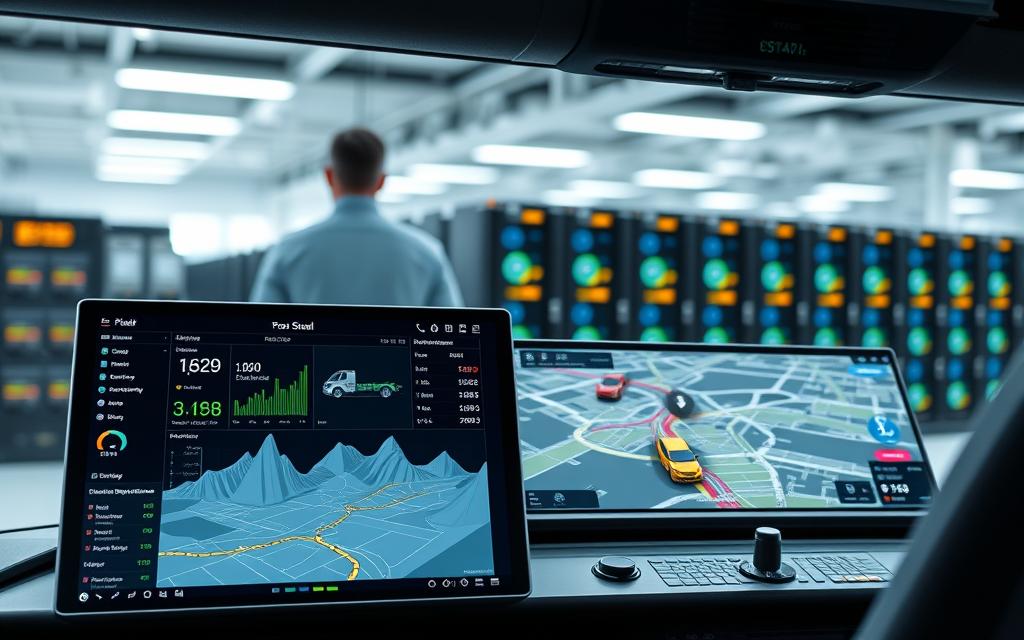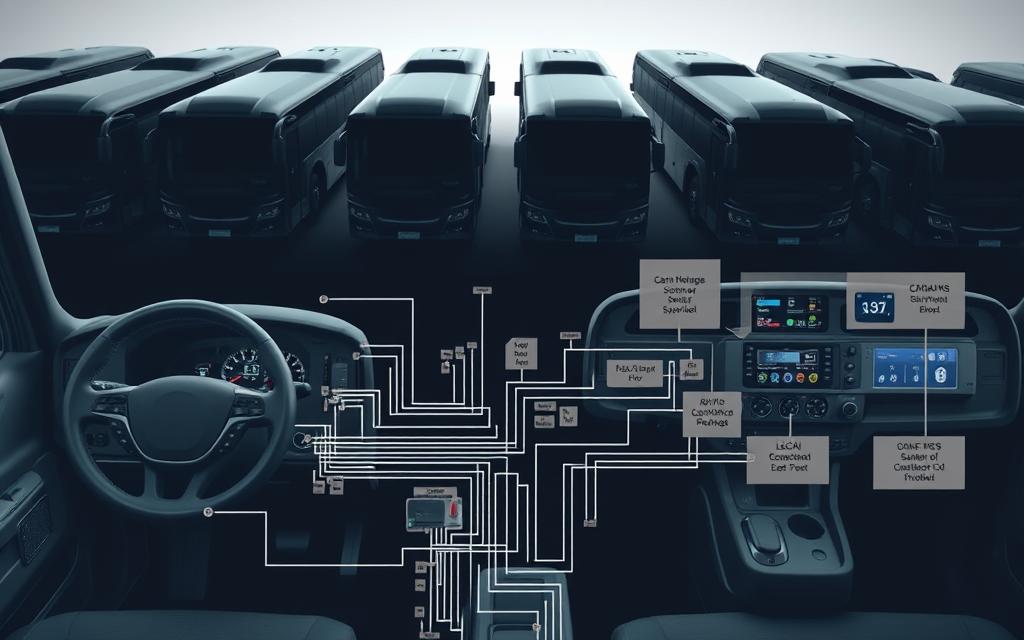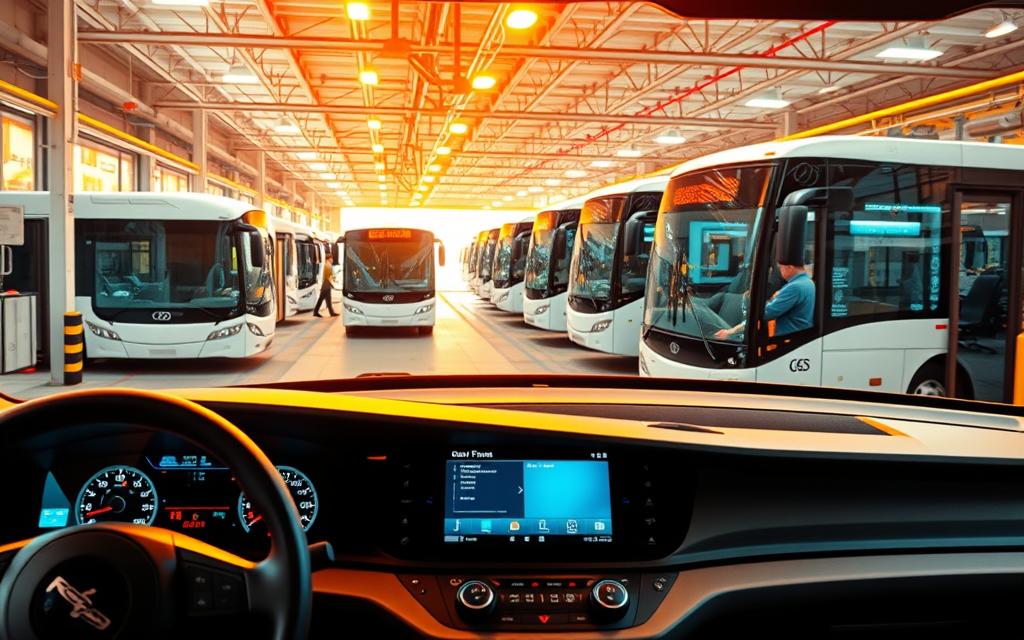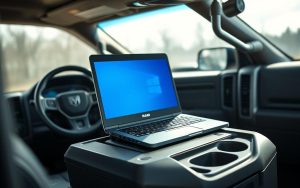Table of Contents
Arizona’s transportation network relies on advanced technology to keep students safe and operations efficient. With over 220 school districts, modern fleet management tools are essential for smooth daily operations.
From telematics to real-time tracking, these solutions enhance safety and fuel efficiency. The state also integrates systems like Zonar in Glendale, setting a benchmark for success.
Adopting these innovations helps meet sustainability goals while ensuring compliance. Real-time data plays a crucial role in decision-making and regulatory adherence.
Introduction to Bus Fleet Technology in Arizona
Extreme heat and vast distances make fleet management critical for Arizona’s schools. With temperatures exceeding 100°F and rural routes spanning miles, reliable vehicle tracking ensures student safety and operational efficiency.
Decades ago, drivers relied on paper logs and manual checks. Today, IoT-connected telematics monitor everything from engine health to route deviations. Over 68% of large districts now use these tools, per AZ DoT 2023 data.
Route optimization is a top priority for 140,000+ daily riders. Advanced software adjusts paths in real-time, reducing delays. These solutions also integrate with statewide emergency alerts, speeding up crisis response.
Federal grants cover 40% of tech upgrades, easing budget constraints. Districts invest in workforce training to maximize new systems. From diagnostics to driver coaching, modern transportation tools are reshaping Arizona’s student transit.
What Computer Systems Do Bus Fleets Use in Arizona?
Modern student transportation relies on smart technology to enhance safety and efficiency. Across the state, districts deploy three core systems: telematics for tracking, specialized software for logistics, and CAN bus networks for diagnostics.
Telematics Devices for Real-Time Tracking
GPS-enabled telematics provide pinpoint accuracy, with HD-GPS narrowing locations to within 3 feet. Tools like Verizon Connect monitor electric vehicle charging status, ensuring optimal performance.
These devices sync with student databases, automating route adjustments for delays or emergencies. Real-time alerts notify dispatchers of speed violations or unscheduled stops.

Fleet Management Software Solutions
Cloud-based platforms centralize data, from maintenance schedules to driver behavior reports. Webfleet’s solutions leverage OBD-II ports to detect engine issues before they cause breakdowns.
Automated workflows slash paperwork.
“Electronic inspections cut pre-trip checks from 15 minutes to 5,”
notes a Glendale transport supervisor.
CAN Bus Systems for Vehicle Communication
These networks enable direct vehicle component communication without a central computer. ECUs share 150+ parameters—from tire pressure to battery voltage—enabling predictive maintenance.
Cybersecurity protocols encrypt student data, ensuring FERPA compliance. CAN bus reliability reduces downtime, keeping fleets operational in Arizona’s harsh climate.
Telematics: The Backbone of Modern Bus Fleets
Telematics revolutionize student transportation with real-time insights. These tools provide actionable data, enhancing safety and operational efficiency. Districts leverage them to monitor vehicles, drivers, and routes seamlessly.
Real-Time Data Collection and Analysis
GPS tracking delivers live updates on bus locations, accurate within 3 feet. Historical data predicts traffic patterns, reducing delays by 18%. Alerts notify dispatchers of unscheduled stops or mechanical issues.
Automated reports simplify compliance.
“Telematics cut inspection time by 67%,”
notes a Phoenix fleet manager. Integrated cameras analyze driver behavior, further improvingsafetystandards.
Safety Features: Speed Monitoring and Route Adherence
Haptic feedback alerts drivers during speeding or off-route deviations. NHTSA reports a 14% drop in accidents with these systems. Geofencing triggers warnings for unauthorized stops.
Dynamic rerouting avoids hazards like flash floods. Emergency response times improve by 23%, critical for rural areas. Real-time tracking ensures no child is left behind.
Fuel Efficiency and Cost Reduction
Idle-time monitoring saves 11% on fuel costs annually. Predictive maintenance reduces breakdowns, lowering repair expenses. The table below highlights key savings:
| Feature | Impact | Annual Savings |
|---|---|---|
| Idle Alerts | Reduces engine runtime | $4,200 per vehicle |
| Route Optimization | Cuts unnecessary miles | 15% fuel reduction |
| EVIR Inspections | Prevents costly repairs | $1,800 per bus |
Pump price analytics integrate with fuel cards, ensuring budget adherence. These innovations make telematics indispensable for modern fleets.
CAN Bus Systems in Arizona’s Buses
Behind every efficient student transport operation lies a robust communication network. CAN bus systems enable seamless data exchange between vehicle components, eliminating the need for complex wiring. These networks are critical for real-time diagnostics and performance monitoring.

How CAN Bus Works in Fleet Vehicles
CAN bus technology uses four frame types: data, error, overload, and remote. Each frame prioritizes critical data, like engine temperature or brake status. The J1939 protocol standardizes communication for heavy-duty vehicles, ensuring compatibility across manufacturers.
Compared to traditional setups, CAN reduces wiring complexity by 60%. This streamlined design enhances reliability, especially in Arizona’s extreme heat. Over-the-air updates keep ECU firmware current without manual intervention.
Applications for Fleet Management
These systems integrate with ABS and airbag solutions for enhanced safety. Predictive alerts notify management teams of potential transmission failures or battery issues in electric buses. Cybersecurity measures encrypt network traffic, protecting sensitive student information.
- Real-time battery health monitoring for EV conversions
- Automated fault detection with 99.98% accuracy
- Geofencing triggers for unauthorized route deviations
Benefits: Centralized Diagnostics and Robust Performance
Centralized data access simplifies maintenance scheduling and reduces downtime. The table below highlights key advantages over traditional methods:
| Feature | CAN Bus | Traditional Systems |
|---|---|---|
| Error Detection | 99.98% | 85% |
| Wiring Complexity | Low | High |
| Update Method | Ota | Manual |
These innovations ensure fleets meet stringent safety standards while optimizing performance. With faster response times and lower costs, CAN bus systems are transforming student transportation.
Case Study: Glendale’s Success with Zonar
Glendale’s transportation team transformed operations with smart fleet innovations. By integrating Zonar’s solutions, they achieved measurable gains in efficiency, safety, and cost control. This case study highlights their journey from manual processes to data-driven decision-making.

Implementing EVIR for Inspections
Digital inspections replaced paper logs, slashing paperwork time by 78%. EVIR (Electronic Vehicle Inspection Reports) automated pre-trip checks, catching issues like tire wear or fluid leaks instantly.
“EVIR cut inspection errors by 90%,”
reported a Glendale fleet supervisor. Real-time data syncs with maintenance teams, ensuring swift repairs.
Reducing Miles and Fuel Consumption
Route optimization tools trimmed 36,000 miles annually—a 4% reduction. GPS tracking identified inefficient paths, while historical data refined schedules. Fuel savings hit 22,400 gallons (7%), aided by idle-time alerts. Key results:
| Metric | Improvement | Annual Impact |
|---|---|---|
| Mileage | 4% reduction | 36,000 fewer miles |
| Fuel Use | 7% savings | 22,400 gallons saved |
| Supervising | GPS efficiency | 1,000 fewer miles |
Geofencing and Idle Time Monitoring
Automated geofences triggered speed alerts in school zones and landfills. Idle-time benchmarks revealed driver-specific habits, enabling targeted coaching.
- Lift-arm sensors resolved customer disputes faster.
- Zonar’s dashboard analytics streamlined management.
- Real-time alerts reduced unauthorized stops by 62%.
Glendale’s success proves how technology elevates fleet service. With Zonar, they turned data into actionable insights—saving time, fuel, and resources.
Electronic Vehicle Inspection Reports (EVIR/DVIR)
Digital inspection tools are transforming how fleets ensure roadworthiness. Electronic Vehicle Inspection Reports (EVIR/DVIR) replace error-prone paper logs with streamlined workflows. Districts now achieve a 92% inspection completion rate—up from 67% with manual methods.
Streamlining Pre- and Post-Trip Inspections
Custom checklists adapt to Arizona’s heat-specific needs, like tire pressure thresholds. Technicians capture defects via photo uploads, reducing disputes. Maintenance teams receive instant alerts for urgent repairs, cutting turnaround time by 34%.
- Safety enhancements: Digital sign-offs with timestamps ensure accountability.
- Parts inventory syncs with repair orders, minimizing downtime.
- Historical data predicts component lifespans, optimizing replacement schedules.
Compliance and Maintenance Benefits
EVIR automates FMCSA compliance, generating audit-ready reports in seconds.
“Photo documentation resolved 90% of liability claims,”
notes a Phoenix fleet director. Real-time vehicle health updates further reduce roadside failures.
Key advantages over manual processes:
| Metric | EVIR | Paper Logs |
|---|---|---|
| Inspection Accuracy | 98% | 72% |
| Repair Speed | 34% faster | Delays common |
| Regulatory Audits | Automated | Manual compilation |
These innovations elevate safety while simplifying maintenance workflows. With EVIR, fleets turn inspections into strategic assets.
Cost-Saving Technologies for Bus Fleets
Smart technology helps school districts maximize budgets while improving transportation safety. Advanced tools now reduce operational costs through fuel optimization, preventative care, and risk mitigation. These innovations prove essential for maintaining service quality amid rising expenses.

Telematics Cut Fuel Expenses
Real-time monitoring reduces fuel waste by 11-15% annually. Idle-time alerts and route optimization slash unnecessary engine runtime. The table below shows typical savings:
| Feature | Impact | Annual Savings |
|---|---|---|
| Idle Alerts | Limits engine runtime | $3,800 per vehicle |
| Route Analytics | Reduces mileage | 1,200 gallons saved |
| Speed Coaching | Improves MPG | 9% efficiency gain |
Integrated fuel cards with pump price analytics ensure budget compliance. Districts report 22% fewer unplanned repairs through early issue detection.
Preventative Maintenance Strategies
Proactive care extends vehicle lifespans while lowering costs. Key approaches include:
- Predictive battery replacement scheduling
- Tire pressure monitoring systems
- Warranty compliance tracking for components
“Automated alerts reduced our downtime by 34% last year,”
notes a Tucson transportation director. Historical maintenance data optimizes part replacement cycles.
Insurance Benefits Through Safety Tech
Telematics-equipped fleets qualify for 17% lower premiums. Driver certification programs further reduce risks. Key advantages:
- Customized rates via insurance telematics programs
- Crash reconstruction data disputes false claims
- Geofencing lowers unauthorized use incidents
These safety measures create measurable costs reductions while protecting students. Districts reinvest savings into newer, more efficient vehicles.
Future Trends in Bus Fleet Technology
Innovation drives the next era of student transportation, with cutting-edge solutions reshaping fleet operations. Emerging technology combines sustainability, intelligence, and robust privacy measures. Districts are preparing for mandates like Maricopa County’s 2026 requirement for 30% electric buses.
Electrification and Smart Charging Networks
The shift to zero-emission vehicles is accelerating. Electric bus adoption brings unique challenges like battery degradation monitoring. Machine learning models now predict cell lifespan with 94% accuracy.
Key developments include:
- Dynamic load balancing across charging stations
- Solar-powered depots with vehicle-to-grid capabilities
- Thermal management systems for extreme heat operation
Intelligent Predictive Maintenance
AI transforms raw data into actionable insights. Vibration analysis detects bearing failures 3 weeks before breakdowns. Augmented reality guides technicians through complex repairs, cutting service time by 40%.
“Our predictive models reduced unplanned downtime by 52% last quarter,”
reports a Phoenix-area fleet director. These tools integrate with blockchain-based maintenance records for tamper-proof documentation.
Next-Generation Data Security
New privacy protocols mirror GDPR standards for student information. Cybersecurity mesh architectures isolate sensitive data while allowing fleet benchmarking through anonymized pools. The table below contrasts current and future approaches:
| Feature | Current | 2025+ |
|---|---|---|
| Access Control | Role-based | Behavioral biometrics |
| Data Storage | Centralized | Edge computing nodes |
| Encryption | AES-256 | Quantum-resistant |
These advancements ensure management teams can harness technology safely. As solutions mature, they’ll redefine efficiency and safety standards nationwide.
Conclusion
Investing in modern fleet technology delivers measurable savings and safety gains. Medium districts can achieve $4.2M annual savings through telematics and predictive maintenance.
CAN bus solutions are critical for electrification, enabling real-time diagnostics. Emerging V2X standards will further streamline management workflows.
Workforce training ensures teams maximize these tools. Districts should evaluate ROI frameworks and explore state funding for upgrades.
Contact local agencies to tailor fleet strategies to your operational needs.
FAQ
What types of fleet management software are used in Arizona’s bus fleets?
Popular solutions include Zonar, Samsara, and Geotab. These platforms offer real-time tracking, fuel monitoring, and driver behavior insights to optimize efficiency and safety.
How do telematics devices improve bus fleet operations?
They collect vehicle data, track speeding, and optimize routes to reduce fuel costs. Managers gain insights into driver performance and maintenance needs for proactive decision-making.
What role do CAN Bus systems play in fleet vehicles?
These systems enable centralized diagnostics, monitoring engine health and emissions. They help fleet managers detect issues early, ensuring compliance and minimizing downtime.
Can electronic inspection reports (EVIR/DVIR) streamline compliance?
Yes. Digital forms automate pre-trip inspections, ensuring buses meet safety standards. They also store records for audits, reducing paperwork and improving regulatory adherence.
How does geofencing benefit bus fleets?
It sets virtual boundaries to monitor unauthorized vehicle use and idling times. This feature enhances route efficiency and cuts unnecessary fuel expenses.
What future technologies will impact Arizona’s bus fleets?
Electric vehicle integration, AI-driven predictive maintenance, and enhanced data encryption for privacy are key trends. These innovations aim to boost sustainability and operational transparency.









